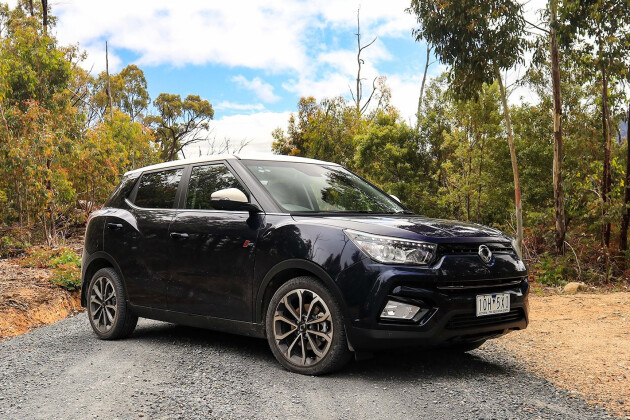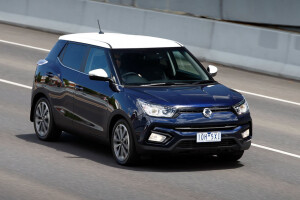Latest Review

2019 Ssangyong Tivoli review
Ssangyong lands back in Australia with the Tivoli, but has it come too soon?
Korea’s third-largest automaker SsangYong is back for another crack at the overheated, oversized and price-sensitive Australian market – this time as a factory-owned importer.
One of the tines of its three-pronged launch strategy is the small Tivoli SUV, which will be brought in with both diesel and petrol engines, manual and automatic gearboxes and front- or all-wheel-drive.
However, this car is already a few years old, and somewhat inexplicably, there’s a facelifted version on the very near horizon. Still, this version is coming to one of 32 SsangYong showrooms potentially near you, so let’s have a look.
VALUE
The five-seat, five-door Tivoli kicks off at $23,490 drive-away – and that’s national drive-away pricing, too – for a six-speed manual-equipped 1.6-litre petrol-powered variant known as the EX. Add $2000 and you’ll get a six-speed auto version. Both are front-wheel-drive, as well.
This undercuts pretty much every player in the small SUV segment, including the Mazda CX-3, Mitsubishi ASX and Hyundai Kona.
If Sir or Madam would like the mid-range ELX, you can have a petrol-powered auto front-driver for $27,490, or a 1.6-litre diesel powered auto front-driver for $29,990.
The top-spec Ultimate is available only as an all-wheel-drive diesel for $33,990.
STANDARD FEATURES
Not only is the Tivoli cheap, but by all measurement it’s pretty well equipped, especially the base model.
Standard kit for the entry-level model EX includes AEB, six airbags, cloth trim and a leather-wrapped steering wheel, 16-inch alloys, front and rear parking sensors, lane-keep assist, Apple CarPlay and Android Auto and a 7.0-inch multimedia system.
The ELX variant only gets a little more stuff, though, including dual-zone air and tinted glass.
The Ultimate, meanwhile, gets a full-size spare, sunroof, heated, vented and powered front seats, leather upholstery and 18-inch alloys.
SIZE
At 4202m long, the Tivoli is about 140mm shorter than the category-leading Mitsubishi ASX.
One of the issues in the small SUV space is finding one with half-decent boot capacity. The category leaders are the ASX at 393 litres VDA with the seats up, while the Honda HR-V claims 437 litres. The Tivoli claims a seat-up figure of 423 litres, while its squared-off roofline makes for a practical space.
SAFETY
SsangYong boasts that more than 70 per cent of the Tivoli’s construction is comprised of high-strength steel, while 40 per cent of that mix is made up of even stronger advanced high-strength steel. Every model in the Tivoli range also comes with AEB, forward collision warning, lane departure warning, lane keep assist and high beam assist, as well as six airbags including a driver’s knee bag.
However, this version of the Tivoli only scored four out of five stars under Euro NCAP – and consequently ANCAP – crash testing, thanks to a poor performance for rear passenger safety.
WARRANTY AND RUNNING COSTS
SsangYong has hit the ground running with its after-sales offering, with a seven-year, unlimited-kilometre warranty that’s matched with seven years’ worth of fixed price servicing and seven years of roadside assistance.
Service intervals of 12 months or 15,000km are suggested, though service costs for the SsangYong range are yet to be released.
Both the petrol and the diesel versions share a 47-litre fuel tank, while fuel economy ranges from a best of 5.5 litres per 100km on the combined cycle for the diesel manual and 5.9L/100km for the FWD diesel auto to 6.6 and 7.2L/100km respectively for the petrol manual and auto.
COMFORT
The Tivoli’s front seats are reasonably well placed, though there’s not enough adjustment in the steering column to get perfectly comfortable for my 185cm.
Rear seats are spacious enough, and the door aperture is wide enough for easy access. Rear headroom is good – though the Ultimate’s sunroof stole a bit away – and knee room is average-to-good for a small SUV. You’ll find a pair of ISOFIX baby seat mounts in the rear, as well.
The interior is pretty nicely executed, with decent-sized door pockets, nice use of materials and understated yet stylish instrumentation.
ON THE ROAD
This is, unfortunately, where we are left wondering if SsangYong should have just waited until the arrival of the significantly facelifted version of the Tivoli later in 2019… because this one as it sits is pretty badly underdone.
My key issue with the car is just how early and savagely the Tivoli’s traction control and stability control systems cut in to kill power to the car. I’ve never felt anything quite like it, in fact. Even at moderate pace into a pretty open bend, the Tivoli’s electronics overreact and viciously power from the engine to prevent traction loss, resulting in a feeling as if you’ve jumped on the brakes from a great height.
To me, it felt like an issue with the actual example of the car, but every car I tried was the same, and a senior official told me that’s how it’s supposed to be. And I’m not talking about race track hero stuff, either, just a moderately brisk pace well within speed limits.
As well, SsangYong Australia will soon embark on a program of suspension localisation for the car, which kind of renders our observations irrelevant. For the record, it’s not bad in its stock form, if a bit wooden and numb, with decent enough steering feel and good manners in loose conditions… when the electronics are turned off.
There’s a decent little chassis, but the overly high levels of electronic intervention are not really acceptable to this tester.
When it comes to the AWD version, SsangYong actually fits it with a locking rear differential which, when combined with deactivated driver aids, allows it to negotiate gravel roads with ease. However, its relatively low 167mm ride height (compared to the 205mm of an ASX) restricts its ability in rougher stuff.
The 85kW/300Nm diesel engine was the only one available for testing, and while it’s a little gruff, it’s more than willing to lope along at the highway limit. It also plays well with the six-speed Aisin auto, which is a benchmark product in the industry.
VERDICT
The SsangYong Tivoli is a real head-scratcher for me. On the one hand, it offers dirt cheap motoring, a well-executed interior package, excellent basic safety credentials and decent practicality of packaging.
On the other, there will be an all-but-new version of this exact car – engine, suspension, safety, exterior AND interior- by the middle of 2019, and the one we tried was simply not at all calibrated to local conditions or tastes.
It’s pretty clear-cut; if you’re looking something with a bit of room at a good price, and with industry-leading warranty coverage to boot, wait for the facelifted version of the Tivoli which lands half-way through 2019.
News
-
 News
News2019 Suzuki Jimny price and features
Suzuki’s reborn compact offroader arrives in Australia chock-full of equipment, but wearing a budget-friendly price tag.
-
 News
NewsSsangYong 2019 Rexton and 2019 Tivoli SUVs packed with value
SsangYong’s new small and large SUV range offers Apple CarPlay, AEB on all models as the Korean newcomer sets sights on Toyota, Ford, Mitsubishi and Holden customers

